Hong Kong cuisine
Hong Kong cuisine is mainly influenced by Cantonese cuisine, European cuisines (especially British cuisine) and non-Cantonese Chinese cuisines (especially Hakka, Teochew, Hokkien and Shanghainese), as well as Japanese, Korean and Southeast Asian cuisines, due to Hong Kong's past as a British colony and a long history of being an international port of commerce. From the roadside stalls to the most upscale restaurants, Hong Kong provides an unlimited variety of food and dining in every class. Complex combinations and international gourmet expertise have given Hong Kong the reputable labels of "Gourmet Paradise" and "World's Fair of Food".[1]
| Demographics and culture of Hong Kong |
|---|
| Demographics |
|
| Culture |
| Other Hong Kong topics |
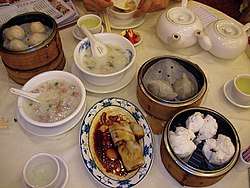
Background
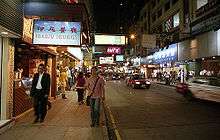
Modern Hong Kong has a predominantly service-based economy,[2] and restaurant businesses serve as a main economic contributor. With the fourth-densest population per square metre in the world and serving a population of 7 million,[3] Hong Kong is host to a restaurant industry with intense competition. Due to its small geographical size, Hong Kong contains a high number of restaurants per unit area.
With Cantonese ethnicity making up 94% of the resident population,[4][5] Cantonese cuisine is naturally served at home. A majority of Chinese in Hong Kong are Cantonese in addition to sizable numbers of Hakka, Teochew and Shanghainese peoples, and home dishes are Cantonese with occasional mixes of the other three types of cuisines. Rice is predominantly the main staple for home meals. Home ingredients are picked up from local grocery stores and independent produce shops, although supermarkets have become progressively more popular.
Hong Kong homes and kitchens tend to be small due to a high population density, and traditional Chinese cuisine often requires the freshest possible ingredients, so food shopping is undertaken frequently and in smaller quantities than is now usual in the West. Take-out and dining out is also very common, since people are often too busy to cook with an average 47-hour work week.[6]
History
19th century: Colonial origins
The cuisine of Hong Kong traces its origins to its founding as a British colonial outpost in 1841. Soon after the colony was founded, many British and other Western merchants along with Chinese from nearby Guangzhou flocked there to conduct business. Initially, much of Hong Kong society was segregated into expatriate Westerners, a majority of working class Chinese coolies, Chinese farmers and fishermen, and Chinese merchants. The simple peasant cuisine was rudimentary compared to the cuisine of 19th century Canton (now commonly known as Guangzhou).[6]
As the colony developed, there arose a need for meals to entertain businessmen. Some Chinese restaurants were founded in the late 19th century and early 20th century as branches of renowned restaurants in Canton and offered elaborate meals consisting of traditional Chinese "eight main courses and eight entrees" (八大八小) types of banquets for 2 taels of silver, at the time equal to a clerk's monthly wage.[7] Before 1935 when prostitution was still legal in Hong Kong, female escorts often accompanied diners to restaurant meals, especially those of a business entertainment nature.'Until World War II, opium was also offered. For the majority of Chinese who were not part of the merchant class, dining out in restaurants was non-existent and consisted of simple Cantonese country fares. Meat only appeared in festive occasions and celebrations such as birthdays were often done by catering services who prepared the meals at the celebrant's home. The restaurant scene for Europeans in Hong Kong was segregated from Chinese dining. Elaborate colonial dining existed at the likes of Hongkong Hotel and subsequently Gloucester Hotel.
1920s: Cantonese influence
Hong Kong's dining lagged behind the then-leader of Chinese cuisine, Canton, for a long time and many Hong Kong chefs spent their formative years in Canton. Canton was renowned for its food, and there was a traditional saying of "The food is in Canton" (食在廣州).[8] Cantonese cuisine in Canton reached its peak during the 1920s and was renowned in the care in preparation even for peasant fares such as char siu or boat congee. Dasanyuan was renowned for its braised shark fin dish that charged 60 silver yuan, equivalent to 6 months' wage for a working-class family.[9] The Guandong cooking style eventually trickled down to the culinary scene in Hong Kong.[10]
1949: Shanghainese and Western influences
The victory of Chinese Communists in the Chinese Civil War in 1949 created a wave of refugees into Hong Kong. A sizeable number of refugees were from non-Cantonese speaking parts of China, including the Yangtze River Delta, and introduced Shanghai cuisine to Hong Kong. On the other hand, most renowned chefs of Canton, now known as Guangzhou in pinyin romanisation, settled in Hong Kong to escape from Communist rule in mainland China.[11]
Prostitution and opium had by then long faded from the restaurant scene, and to survive, many restaurants started to tap into winning business from families by offering yum cha and wedding banquets, while on the other hand, the end of strict colonial segregation by the British colonial government and expatriate Westerners after the Second World War opened up Western fare to the Chinese.
Egg tarts and Hong Kong-style milk tea soon became part of Hong Kong's food culture. It could be argued that the seeds of Hong Kong society as understood today were not sown until 1949, and the cuisine of Hong Kong has its direct roots in this period.
1960s–80s: prosperity
By the 1960s, Hong Kong was past the worst of the economic depression, and there was a long and continuous period of relative calm and openness compared to the Communist rule in Mao Zedong-era China and martial law isolation in Taiwan. The Cantonese cuisine in Hong Kong had by then surpassed that of Guangzhou, which had witnessed a long period of decline after the Communists came to power. The rising prosperity from the mid-1960s had given birth to increasing demand for quality dining. Many of the chefs, who spent their formative years in pre-Communist Guangzhou and Shanghai, started to bring out the best of fine dining specialties from pre-1949 Guangzhou and Shanghai. Families had largely abandoned catering services and resorted to restaurants for celebratory meals.[12] Seafood started to become specialised delicacies in the 1960s, followed by game in the 1970s.
This wave of prosperity also propelled Hong Kong Chinese's awareness of foreign food trends, and many were willing to try foreign ingredients such as asparagus and crayfish from Australia. Foreign food styles such as Japanese and Southeast Asian cuisine started to influence local food, and the pace of change accelerated during the late 1970s and early 1980s. This gave birth to nouvelle Cantonese cuisine (Chinese: 新派粵菜; Cantonese Yale: Sānpaai Yuhtchoi) that incorporated foreign dishes such as sashimi into Cantonese banquets.[13] For the first time, many Hong Kong Chinese started to have the economic means to visit many Western restaurants of the domain of mainly wealthy expatriate Westerners such as Gaddi's of the Peninsula Hotel. During these years, there was great wealth growth from stock market investments, and one visible manifestation of the resultant nouveau riche mentality in 1970s Hong Kong were sayings such as "mixing shark's fin soup with rice" (Chinese: 魚翅撈飯; Cantonese Yale: Yùhchi Lōufaahn).
1980-90s: links with mainland China and Taiwan
China initiated economic reforms when Deng Xiaoping came to power after Mao Zedong died. The opening up of the country gave chefs from Hong Kong chances to reestablish links with chefs from mainland China severed in 1949 and opportunities to gain awareness of various regional Chinese cuisines. Many of these cuisines also contributed to nouvelle Cantonese cuisines in Hong Kong.[14] The lift of martial law in Taiwan in 1987 jump-started Taiwanese links with mainland China and has caused a proliferation of eateries specialising in Taiwanese cuisine in Hong Kong as Taiwanese tourists and businessmen used Hong Kong as a midpoint for visits to mainland China. From 1978 until 1997 there was no dispute Hong Kong was the epicenter of Chinese, not merely Cantonese, cuisine worldwide, with Chinese restaurants in mainland China and Taiwan, and among overseas Chinese communities, racing to employ chefs trained or worked in Hong Kong and emulating dishes improvised or invented in Hong Kong. Hong Kong-style Cantonese cuisine (Cantonese Yale: Góngsīk Yuhtchoi) became a coinword for innovative Chinese cuisine during this period.[15] It was even unofficially rumoured the Chinese government had secretly consulted the head chef for the Peking Garden Restaurant of Hong Kong, part of the Maxim's restaurant and catering conglomerate, to teach chefs back at the renowned Quanjude restaurant in Beijing how to make good Peking duck, Quanjude's signature dish, in the early 1980s as the skills to produce the dish were largely lost during the Cultural Revolution.
Post-1997
After Hong Kong was returned to China in 1997, the Asian financial crisis and SARS epidemic led to a decade-long depression. The boom in Hong Kong culinary scene came to a halt and many restaurants were shuttered, including a number of renowned eateries such as Sun Tung Lok. It is argued that the catch up in prosperity among populations from coastal regions of China, particularly the nouveau riche (derogatory Chinese: daai foon 大款) and corrupted officials (derogatory Chinese: daai ye 大爺), has driven up the demand of many delicacies such as abalone and grouper, and many celebratory dishes have become outrageously expensive that they are beyond the reach of even many upper-middle class Hong Kong families. At the same time, Hong Kong people's tastes have become cosmopolitan when compared with one generation ago. Many are now able to appreciate specific European cuisines rather than one generic "Western cuisine", and appreciation of other Asian cuisines, especially Japanese cuisine and Thai cuisine has been ever increasing. These have produced a proliferation of many specialist ethnic cuisine restaurants geared towards young middle class couples on one hand, and a consolidation of fine-dining Cantonese restaurants on the other.
As of the early 21st century Hong Kong, notwithstanding the partial recovery of Hong Kong's economy from the slump in 2003 due to the SARS epidemic, many pundits argue that contemporary Hong Kong's economy is heavily skewed towards real estate development and financial services. This provides prosperity to only a select few minority and an uncertain long-term economic fortune vis-a-vis more diversified mega-rich cities in China such as Shanghai and Guangzhou, and the territory therefore no longer possesses the economic base to support mass-level super fine-dining that is required to sustain an active dining culture. A common perception of Hong Kong's current culinary culture is one being in decline and resting on past laurels. For example, culinary magazines such as Eat and Travel Weekly report fewer fundamentally new dishes being invented in Hong Kong post-2000 than the 1980s heyday, and many restaurants tend to resort to popularise haute dishes invented in the 1980s. Modern Hong Kong's labour market has also disrupted the traditional ways of grooming Chinese chefs, which henceforth been trained in a very long and drawn one-to-one practical apprenticeships. Very few chefs are willing to sacrifice their time and effort to produce traditional cooking that discourages cutting corners, and emphasises techniques over ingredients' net economic worth.[16] On the other hand, a minority of optimistic pundits argue Hong Kong may well develop a foodie culture similar to other developed economies and preserve the best of traditional cooking.
Historically, Hong Kong's food source came from a combination of mini stores instead of supermarkets. Some of the stores included: rice dealers (Chinese: 米舖; Cantonese Yale: Máihpou), serving as mini rice storage warehouses; wine shops (Chinese: 辦館; Cantonese Yale: Baahn gún), which offered beverages; convenient stores (Chinese: 士多; Cantonese Yale: Sidō, Cantonese rendering of "store"), which were single convenient stores, most notable for serving fresh baked bread. The main component was wet markets (Chinese: 街市; Cantonese Yale: Gāaisíh) – one of the first market gatherings in Hong Kong was Central Market that began in the 1840s.
The idea of a single facility or supermarket that provided all food ingredients did not take place until the early 1970s when Wellcome, a local grocery chain, changed its format into a supermarket. Air-conditioned supermarkets did not become standardised until the 1980s. The early 21st century Western environmentalism- or sustainability-inspired food trends, such as natural food, organic food, non-genetically modified food, local food, and farmer's markets, have been ignored by a majority of Hong Kong's populations. The Western farmer's market share some similarities with the traditional Chinese wet markets, however support of wet markets is largely based on traditional Chinese cultural preference rather than sustainability, and wet markets contain many features that are condemned by modern Western environmentalists on the grounds of "animal cruelty" (live animals sold for food) and "high food miles" (fruits and seafood from another continent).
Eating habits
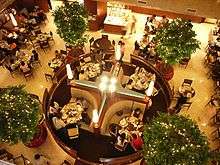
Most restaurant serving sizes are considerably small by international standards, especially in comparison to most Western nations like the United States and Canada. The main course is usually accompanied by a generous portion of carbohydrates such as rice or mein (noodles). People generally eat 5 times a day.[1] Dinner is often accompanied with desserts. Snack time also fits anywhere in between meals.
As Hong Kong is Cantonese in origin and most Hong Kong Chinese are immigrants or descendants of immigrants from Cantonese-speaking regions of China, the food is a variant of Cantonese cuisine – almost all home-cooking and much of the dine-out fares, from restaurant to bakery, are Cantonese or heavily Cantonese-influenced. Most of the celebrated food in Hong Kong such as the wife cake, roast duck, dim sum, herbal tea, shark's fin and abalone cooking, poached chicken, and the mooncake, and others, originated in nearby Guangzhou, and dai pai dong was an institution adopted from the southern Chinese city. As in the parent cuisine, the Hong Kong Cantonese cuisine accepts a wide variety of ingredients, a lighted seasoned taste. Unlike Guangzhou, the uninterrupted contacts Hong Kong has with the West has made it more susceptible to Western influences, and has produced favourites such as egg tarts and Hong Kong-style milk tea.
In addition, other foreign styles of cuisines are also popular in the territory, although almost all offer one of generic Western (authentic, international, or Hong Kong-style), Italian, French, Korean, Japanese, Thai, Vietnamese, Indian, Indonesian, Malaysian and Singaporean cuisines.
| Time of Day | Meal |
|---|---|
| morning (until 11am) | Breakfast |
| noon (12-2 pm) | Lunch |
| 3 pm | Afternoon Tea |
| evening | Dinner |
| 10 pm or later | Siu yeh |
Eating etiquette
Most East Asian cuisines, with the exception of fusion and Thai, are consumed exclusively with chopsticks; to ensure good hygiene, customers are to have two pairs of chopsticks, one to pick up food to put on their plate, and one to eat with. The more Western style cuisines favour cutlery. Some meals are more suited for the use of hands. One notable trend in restaurants is the limited number of napkins provided during a meal. Most mid to low-tier restaurants operate under the assumption that customers bring their own napkins or tissue packs when dining. In all cases, there is no ice water, instead preferring hot water; this is because of the belief that water that is cold to begin with is not sanitary to drink.
Ingredients
Similar to Cantonese cuisine elsewhere, Hong Kong's cooking uses a wide variety of ingredients and the common ones include:
|
Styles
Chinese and other Asian
| Chinese and other Asian cuisines | Style name | Most popular | Examples |
|---|---|---|---|
| Small Shops | Hawker | Snack | Fish balls on a stick, Stinky tofu |
| Dai Pai Dong | Snack | Wonton noodle, Congee | |
| Specialty | Snack | Tofu pudding, beef jerky | |
| Informal | HK-Style Fast Food | Anytime | Cutlet Porkchop, Vegetable with Oyster sauce |
| Bakery | Chinese Pastry | Snack | Wife Cake, Egg tart, Pineapple Bun |
| Cantonese | Lunch, Dinner | Dim sum (breakfast, lunch and afternoon tea only), Shark's fin, Char siu | |
| Buddhist | Lunch, Dinner | Buddha's delight, Mantou | |
| Hakka | Lunch, Dinner | Poon choi | |
| Beijing | Lunch, Dinner | Peking duck | |
| Japanese | Lunch, Dinner | Sushi, Sashimi | |
| Indian | Lunch, Dinner | Curry chicken | |
| Hot Pot | Dinner | Scallop, Shrimp | |
| Drinks | HK-Style Drinks | Anytime | Milk tea, Yuanyang |
| Chinese Tea | Anytime | Chrysanthemum tea, Jasmine tea | |
Western
| Western Category | Style Name | Most Popular | Examples |
|---|---|---|---|
| Small Shops | HK-style western | Brunch | French toast, Instant noodles |
| Informal | Western Fast Food | Anytime | Burger, Hot dog, Club sandwich, French fries |
| Bakery | Western Bakery | Snack | Maxim, Tiramisu, Portuguese egg tart |
| Cuisine | American | Lunch, Dinner | Sirloin steak, Buffalo wings |
| Italian | Lunch, Dinner | Spaghetti with Vienna Sausage, Beef Brisket, Pizza | |
| French | Lunch, Dinner | Quiche, Lamb Mignon | |
| Drinks | Western Drinks | Anytime | Horlicks, Cola |
| Western Coffee | Anytime | Espresso, Iced coffee, Siphon Coffee | |
Non-service-based
Non-service-based items are food that do not require cooking or any chef services. They are usually imported, cultivated or produced. It is identical if served outside of Hong Kong.
| Category | Style Name | Most Popular | Examples |
|---|---|---|---|
| Alcoholic | Beer | Lunch, Dinner | Tsingtao, Carlsberg, Heineken |
| Wine | Lunch, Dinner | XO cognac | |
| Fruits | Pacific Fruits | Anytime | Ya Pear, Durian, Lychee |
Chinese and other Asian styles
Hawker
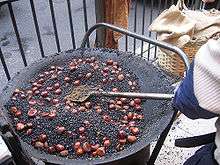
These are basically streetside food stalls, operated by usually one or two people pushing a cart. The carts are usually very mobile, allowing the business freedom to sell snacks in whichever area is most populated at a particular point in time. While they have been popular in the 1970s and 1980s, tight health regulations and other forms of lease versus licensed hawker restrictions have put a burden on this mobile food culture.[17] The term Jau Gwei became associated with the hawkers trying to avoid restrictions.
Includes:
- Fish ball
- Put chai ko
- Roasted chestnuts
Specialty shops
Specialty stores are usually dedicated to selling a certain type of snack or dried goods. If the focus is on beef jerky for example, the store will offer 10 to 20 different types of the highest grade and quality. During holiday times, speciality stores are sometimes the premiere place for purchasing food gift items. Sun-dried goods and Chinese candy are also common merchandise found.
Includes:
- Beef jerky
- Almond biscuit
- Dried shredded squid
Hong Kong-style fast food
Hong Kong-style fast food is either served in fast-casual restaurants such as Café de Coral, Maxim's and Fairwood or in food courts typically attached to malls or supermarkets such as CitySuper. The food offered is a mix of Canto-Western cuisine (see Hong Kong-style Western cuisine below), Cantonese fares, and increasingly Asian food from outside China.
Includes:
- Pork cutlet – Japanese inspired
- Kai-lan (Chinese broccoli) with Oyster sauce – Cantonese
- baked pork chop rice – Western (specifically British) inspired
Chinese pastry
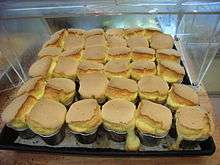
Hong Kong-style Chinese pastry offers a plethora of choices for the discerning taster. Depending on location, some shops may carry a wider selection than others, and some may bake goods on the premise while others have it delivered from an off-site bakery. Most bakeries carry standard fare such as pineapple buns and egg tarts. During the Mid-Autumn Festival, moon cakes are one of the hottest sellers. Pastries are baked fresh daily (and sometimes throughout the day), and it is said that Hong Kong people have taste buds so sophisticated that they can tell the difference between something baked one hour versus five hours ago.
Includes:
Cantonese cuisine

As the most predominant cultural group in Hong Kong, Cantonese food forms the backbone of homecooking and dine-out scenes. Many early celebrated Cantonese restaurants, including Tai San Yuan, Luk Yu Tea House, were originally Hong Kong branches of the famed Guangzhou-based restaurants, and most chefs in Hong Kong until the 1970s had spent their formative years working in the restaurant industry in Guangzhou.[18] Most of the celebrated dishes in Hong Kong were introduced into the territory through Guangzhou, often refined with awareness of international tastes. Cantonese food prices perhaps cover the widest range, from the small businesses lou mei to the most expensive abalone delicacies, which involve abalone.
One well developed dish in Cantonese cuisine is dim sum. Waiters cart around stacks of steamer baskets or small plates of food for customers to choose. Dim sum includes dishes based on meat, seafood, vegetables, as well as desserts and fruit. The term yum cha (literally "drink tea") is synonymous with eating dim sum for Hong Kong people. It is customary for families to eat dim sum on weekends.
Includes:
- Cart noodle
- Siu mei
- Cha siu baau
- Shaomai
- Har gau
- Crispy fried chicken
- Seafood birdsnest
- Pork Knuckles and Ginger Stew
Buddhist cuisine
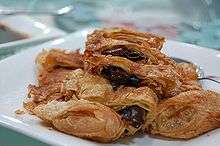
This cuisine is essentially vegetarian specialties using tofu, wheat gluten, mushroom and other non-animal sourced ingredients. Despite the name, the cuisine is enjoyed by many non-Buddhists. Hong Kong's vegetarian dishes, as part of the Cantonese branch of Chinese vegetarian cuisine, puts emphasis on meat analogue substitutes to the point where it can taste and look identical to real meat, often by using deep-fried gluten and tofu to recreate meat-like textures, and heavy-flavoured sauces are prepared for the dishes. Even committed meat-eaters enjoy the cuisine regularly.[19] Unlike western countries, vegetarian diet in Hong Kong is not considered a commitment. This cuisine is also served in some temples and monasteries like the Po Lin Monastery. The vegetarian cuisine served in some Taoist temples or monasteries, such as the Yuen Yuen Institute, can also be classified under this category.
Includes:
Non-Cantonese Chinese vegetarian cuisine is extremely rare in Hong Kong, although there are some isolated temples and restaurants offering Shanghaiese-style vegetarian cuisine. Compared with Cantonese-style vegetarian cuisine, dishes are less oily and some food items favoured by non-Cantonese Chinese, such as bamboo shoot, picked vegetables, are often used. Meat analogues are prominently featured, albeit expressed in differently manners from Cantonese vegetarian cuisine.
Hakka cuisine

This form of cooking style from the Hakka people originally came from Guangdong and Fujian in southeastern China. The style uses dried and preserved ingredients. Pork is by far the most common meat in the style.
Includes:
- Poon choi
- Salt baked chicken
Beijing cuisine
This cuisine has one of the longest histories in terms of style development. The variety and complexity provide a glimpse of what imperial Chinese Emperors might have eaten at one time. Exotic dishes in this category often require a considerable wait time before it is served.
Includes:
Japanese cuisine

Sushi is the most common association made to Japanese cuisine in Hong Kong. From small café shops to conveyor belt sushi restaurants to restaurants specialising in teppanyaki, Japanese-style cooking is fairly popular. Depending on the locale, many sushi-centric restaurants are designed to mirror close to those in Japan.
Includes:
- Sushi with wasabi
- Okinawa soba
Indian and Pakistani cuisine
Hong Kong has a sizeable South Asian community. Unlike in the Indian subcontinent, where food may separate into regional variants, the Chinese population in Hong Kong overwhelmingly identifies Indian cuisine with curry spices. Because meat is always expected, it can also be said that South Asian cuisine in Hong Kong leans toward Northern Indian and Pakistani styles.
Includes:
Hot Pot
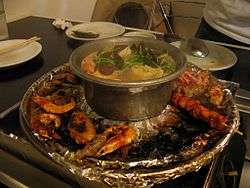
This hot pot cuisine, known as daa bin lou (Chinese: 打邊爐; Jyutping: daa2 bin1 lou4; pinyin: dǎbiānlú) in Cantonese, is unique in the sense that everyone is a chef. A boiling pot of water (soup-based, and customers can choose their preferred soup taste), is placed in the center of the table, and essentially everyone boils their own ingredients in that pot. This is highly popular and is usually accompanied with a bottle of cold beer or soda. This style is common during frigid winter times, since people are essentially huddled around a fire. This format is also considered entertaining.
Includes:
- Beef, pork, chicken
- Crab, prawns, and clams
- Chinese cabbage, carrots and lettuce
- Fish balls and beef balls
- Tofu
Hong Kong-style drinks
Non-alcoholic beverages are served at restaurants of all classes, but most notably at Cha chaan teng, a unique kind of restaurants in Hong Kong. Since drink recipes are not franchise based, most drinks can vary depending on the restaurant. Rock sugar and syrup are commonly used to add sweetness.
Some beverages that was originated in the tea culture of Taiwan, such as bubble tea and honey green tea, had been brought to Hong Kong and become part of Hong Kong's beverage culture.
Includes:
Chinese tea
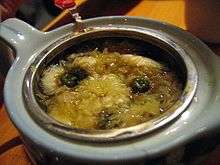
A large wide variety of tea leaves and combinations are used for Chinese tea. In the 1950s and 1960s, citizens would go to tea houses accompanied by their pet birds locked in a bird cage. Noon tea was an essential break in the middle of the day. Tea nowadays goes along with any meal.
Includes:
- Chrysanthemum tea
- Bolay
- 24 flavors
Western styles
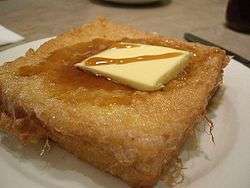
Hong Kong-style Western cuisine
Dishes derived from cuisines of the Western world, but not classified into a particular country, belong in this category. Outside Hong Kong, it is termed Hong Kong-style Western cuisine or Canto-Western cuisine. Small restaurants that offer Sai Chaan are usually cha chaan teng at the popular end or "Sai Chaan Restaurants" at the more upscale range. Restaurants that have come to expect tourists will likely offer both east and west menus. Most dishes are localised with Chinese tastes[21] and contain Chinese and specifically Cantonese influences, such as steak marinated in soy sauce, served in a soy sauce dominated gravy, and with fried rice as on the side, or pasta.[22]
Includes:
- Macaroni in broth with fried egg and sausage
- Fried chicken wings
- Swiss sauce chicken wings
- Instant noodles with sausages
- French toast, called "Western Toast" (西多士 sai do si, shortened from 法蘭西多士 fat laan sai do si, transliteration of French toast) in Chinese
- Hong Kong Style Borscht Soup
Western fast food

Western style fast food are essentially replicas of US or European franchised fast food restaurant models. McDonald's is likely the most common. Others include KFC, Hardee's (formerly), Pizza Hut and many more.
Includes:
Western pastry
The general association made is that western pastries are much sweeter and richer in flavour than typical Chinese pastry. Some eastern-style pastries are similar to their western counterpart, while others are modified by reducing the amount of cheese, cream and other western ingredients. Chinese bakery shops often sell both eastern and western goods. Maxim's is one of the most popular franchises, found in nearly every MTR subway stations. Délifrance is another outlet offering western-style sandwiches.
Includes:
American
These are standard meals taken from the US, except with a significant reduction in usage of butter. For example, an order of mashed potato in Hong Kong will seem relatively plain and light compared to its US counterpart. Popcorn in Hong Kong is heavily sweetened, more resembling caramelised pre-packaged popcorn, such as Cracker Jacks. Steak can be classified as Sai Chaan (Western cuisine) or American food.
Includes:
Italian
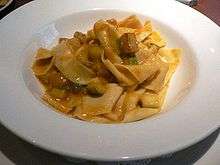
This cuisine is usually considered up-scale, following a three-course antipasto, primo and secondo format. Italian food in Hong Kong is generally considered more Modern Italian, instead of being authentic Traditional Italian (though if one wanted to find a restaurant serving a specific style, such as Venetian, it is possible). Drinks and desserts are often mixed with Chinese options. The main course itself will lean closer to American-Italian. "Fat Angelos" is an example of a Hong Kong-style Italian restaurant.
Includes:
French
Common French dishes can be found in Hong Kong along with delicacies. Many of the French desserts like crème brûlée have been modified into some form of pudding (Chinese: 布甸, bou din) to be served with Chinese dishes. So aside from being a standalone style, influence of French cuisine in Asian dishes is apparent.
Includes:
- Crepes
- Lamb fillet
- Pan fried duck breast
Western Drinks
Beverages from the West have been deeply integrated into the food culture. The line between Eastern and Western drinks are blurred to the point where many Westernised drinks can be found in Chinese style restaurants. Especially in cha chaan teng, they have essentially become just another item on the menu. British malt drinks have become closely associated with breakfast in Hong Kong.
Western drinks include milk, smoothies, berry filled-drinks and so on.
Coffee
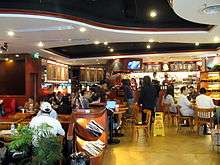
Franchises coffee chains have become more popular in recent years, with the arrival of Pacific Coffee and Starbucks. UCC Ueshima Coffee Co. and Pokka Cafe are among the first to introduce siphon coffee to Hong Kong. This brewing method has only become more familiar to the public after the establishment of Xen Coffee, a siphon speciality coffee shop. While independent coffee shops do exist, franchise stores are often situated in favourable locations that cater to foreign workers.
- Espresso
- Iced coffee
- Frappuccino
- Siphon coffee
Oyster and Wine
Oyster and wine bars have been blooming in recent years. Most of these shops are located in Happy Valley and Tsim Sha Tsui. In Kowloon Peninsula, famous bar districts are located in Tsim Sha Tsui, such as Cameron Street, Peking Street and the Knutsford Terrace.[23] In Hong Kong Island, famous bar districts are located in Wan Chai, such as Fenwick Street, Lockhart Road, Tonnochy Road and Jeffe Road. These areas were recreational spots and resting areas for sailors and foreign navy parking around the 1960s, which contributed to the development of the Wan Chai Bar District.[24]
The history of bars in Hong Kong can be traced back to the 1960s. Around the 1970s, bars in Hong Kong already served a variety of cocktails, beers and also spirits such as gins, whiskeys, brandies and rums, sherries and port wines. In 1978, there were approximately 1757 restaurants with liquor license, only 241 of them were considered as licensed bars. During the 1980s, bars had long opening hours as it was one of the most glorious moments of the bar industry in Hong Kong. The view of neon light signs and slogans used are some of the unique features found in bars from the past.[23]
A noticeable feature of bars in Hong Kong is that 10% service charges have been included in the bill.[25] Applying and keeping a liquor license for a bar costs around 1000 HKD per annual, while liquor licenses for restaurants are at 500 HKD per annual and nightclubs are at 250 HKD per annual.[26]
Locales
Major food districts are Causeway Bay, Kowloon City, Lan Kwai Fong, Tsim Sha Tsui and Soho. Stanley, with its expatriate population, has many seaside pubs and European restaurants. Sai Kung District (mostly in Sai Kung Town), Lamma Island, Lau Fau Shan and Lei Yue Mun serve seafood. Old fishing towns such as Cheung Chau and Tai O also have many original restaurants.
Most pubs and bars are at Lan Kwai Fong, Lockhart Road and Jaffe Road of Wan Chai; Canton Road, Tsim Sha Tsui East; and around Prince Edward MTR station in Mong Kok. Since 1991, Oktoberfest has been held annually on Canton Road.
Hong Kong restaurants and chefs
- Amber (The Landmark Mandarin Oriental Hotel), by Richard Ekkebus
- Nobu Hong Kong at the InterContinental Hotel, by Nobu Matsuhisa
- Fook Lam Moon – traditional Cantonese and dim sum restaurant
See also
- Barbecue in Hong Kong
- Cantonese cuisine
- Macanese cuisine
- Culture of Hong Kong
- Upstairs Cafés in Hong Kong
- List of Chinese dishes
- Private kitchen
- Hong Kong Chefs Association
References
- Sterling, Richard. Chong, Elizabeth. Qin, Lushan Charles [2001] (2001). World Food Hong Kong. Hong Kong: Lonely Planet Publishing. ISBN 1-86450-288-6.
- Hong Kong census. "Census labour data pdf Archived 9 February 2007 at the Wayback Machine." Labor. Retrieved on 14 March 2007.
- HK Census. "HK Census Archived 27 September 2007 at the Wayback Machine." Statistical Table of population. Retrieved on 16 March 2007.
- HK Census. Hong Kong Census Archived 27 September 2013 at the Wayback Machine."
- HK Census. "HK Census Archived 8 December 2007 at the Wayback Machine." Statistical Table. Retrieved on 8 March 2007.
- Steers, Richard. [1999] (1999). Made in Korea: Chung Ju Yung and the Rise of Hyundai. United Kingdom: Routledge. ISBN 0-415-92050-7
- pg 11–12, Famous Cuisine in Hong Kong (香港名菜精選), Wan Li Publishings, Hong Kong, October 1988
- buddhistdoor.com Chinese lifestyle quote Archived 17 August 2009 at the Wayback Machine
- pg 39–41, Special Test Editor (Chan Mun-yan) (特級校對(陳夢因), Tèjí Jiàoduì (Chén Mèngyīn)), History of Cantonese Dishes (粵菜溯源錄), Food and Drink World Publishing Limited, Hong Kong, May 1988
- pg 31, Special Test Editor (Chan Mun-yan), Ibid
- pg 40–41, Special Test Editor (Chan Mun-yan), Ibid
- pg 13–14, Famous Cuisine in Hong Kong (Chinese: 香港名菜精選; Cantonese Yale: Hēunggóng Sānpaai Jūngchoi Jīngwàh)
- pg 11–13, New-Style Chinese Cooking From Hong Kong (Chinese: 香港新派中菜精華; Cantonese Yale: Hēunggóng Sānpaai Jūngchoi Jīngwàh), Wan Li Publishings, Hong Kong, October 1987
- pg 10–11, New-Style Chinese Cooking From Hong Kong (香港新派中菜精華)
- pg14, Famous Cuisine in Hong Kong (Chinese: 香港名菜精選; Cantonese Yale: Hēunggóng Sānpaai Jūngchoi Jīngwàh)
- pg15, Famous Cuisine in Hong Kong (Chinese: 香港名菜精選; Cantonese Yale: Hēunggóng Mìhngchoi Jīngsyún)
- Mau, Stephen D. [2006] (2006). Hong Kong Legal Principles: Important Topics for Students and Professionals. Hong Kong University Press. ISBN 962-209-778-2
- Cheuk Choi (蔡焯, Cài Chāo), pg 4, Preface to Famous Cuisine in Hong Kong (香港名菜精選, Xiānggǎng Míngcài Jīngxuǎn)
- Brown, Jules. Gardner, Dinah. The Rough Guide to Hong Kong and Macau. ISBN 1-85828-872-X
- Peking Duck Archived 27 September 2011 at the Wayback Machine, Chinatown Connection 2005. Retrieved 18 May 2010.
- pg 149, World Food Hong Kong, Richard Sterling and Elizabeth Chong, Lonely Planet, Melbourne, 2002
- AP, Explore the world of Canto-Western cuisine, 8 January 2007 http://www.nbcnews.com/id/16440507 Archived 12 June 2018 at the Wayback Machine
- Courtesy of The University of Hong Kong Libraries (1980s), Night View of Peking Road, retrieved from https://www.hkmemory.hk/MHK/collections/hkplaces/All_Items/images/201107/t20110723_43935.html Archived 7 March 2019 at the Wayback Machine
- Kong Kai-ming(1986).Landmarks of Hong Kong: Further Artistic Impression, p.93, retrieved from https://www.hkmemory.hk/collections/MemoriesWeShare/All_Items/images/201508/t20150825_76024_cht.html?f=search&t=search_datas.jsp&path=channelid=230719%7Csearchword=%E9%85%92%E5%90%A7%7Ckeyword=%E9%85%92%E5%90%A7%7CcssTab=0%7Ctemplet=search_result_all_cht.jsp
- Urban Council Liquor Licensing Board Committee of Urban Council (1979, November 28),City Hall Restaurants and Bars : Price Lists, retrieved from https://mmis.hkpl.gov.hk/coverpage/-/coverpage/view?_coverpage_WAR_mmisportalportlet_hsf=Bar&p_r_p_-1078056564_c=QF757YsWv59%2F7w9HmQIJTQfj7fHgHHz%2B&_coverpage_WAR_mmisportalportlet_o=0&_coverpage_WAR_mmisportalportlet_actual_q=%28%20%28%20allTermsMandatory%3A%28true%29%20OR+all_dc.title%3A%28Bar%29%20OR+all_dc.creator%3A%28Bar%29%20OR+all_dc.contributor%3A%28Bar%29%20OR+all_dc.subject%3A%28Bar%29%20OR+fulltext%3A%28Bar%29%20OR+all_dc.description%3A%28Bar%29%20%29%20%29&_coverpage_WAR_mmisportalportlet_sort_order=desc&_coverpage_WAR_mmisportalportlet_sort_field=score&_coverpage_WAR_mmisportalportlet_filter=dc.publicationdate_dt%3A%5B1970-01-01T00%3A00%3A00Z+TO+1979-12-31T15%3A59%3A59Z%5D&_coverpage_WAR_mmisportalportlet_log=Y&tabs1=CATALOGUE Archived 7 March 2019 at the Wayback Machine
- Urban Council. Food Hygiene Select Committee,Liquor Licensing.(1978, March 19). retrieved from https://mmis.hkpl.gov.hk/coverpage/-/coverpage/view?_coverpage_WAR_mmisportalportlet_hsf=Bar&p_r_p_-1078056564_c=QF757YsWv58Sngm8Qm6MnwkVFHnqE5Qo&_coverpage_WAR_mmisportalportlet_o=5&_coverpage_WAR_mmisportalportlet_actual_q=%28%20%28%20allTermsMandatory%3A%28true%29%20OR+all_dc.title%3A%28Bar%29%20OR+all_dc.creator%3A%28Bar%29%20OR+all_dc.contributor%3A%28Bar%29%20OR+all_dc.subject%3A%28Bar%29%20OR+fulltext%3A%28Bar%29%20OR+all_dc.description%3A%28Bar%29%20%29%20%29&_coverpage_WAR_mmisportalportlet_sort_field=score&_coverpage_WAR_mmisportalportlet_sort_order=desc&_coverpage_WAR_mmisportalportlet_filter=dc.publicationdate_dt%3A%5B1970-01-01T00%3A00%3A00Z+TO+1979-12-31T15%3A59%3A59Z%5D&_coverpage_WAR_mmisportalportlet_filter=verbatim_dc.collection%3A%22Hong+Kong+Collection%22
External links
| Wikivoyage has a travel guide for Hong Kong Culinary Tour. |
| Wikimedia Commons has media related to Cuisine of Hong Kong. |